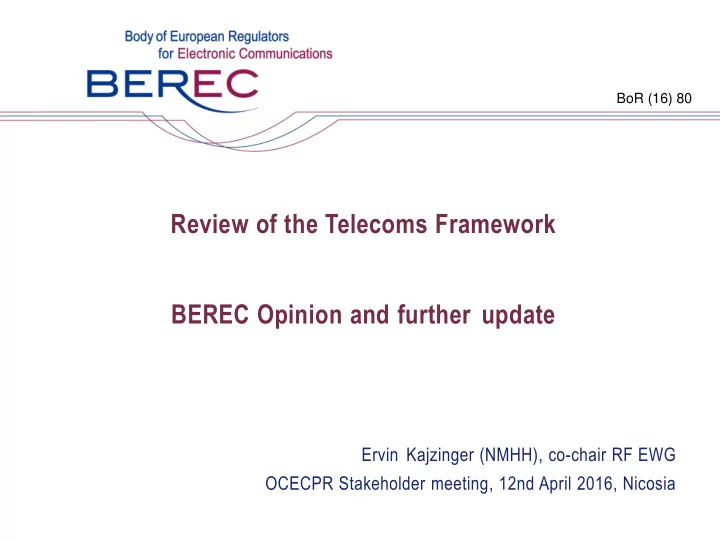

BoR (16) 80 Review of the Telecoms Framework BEREC Opinion and further update Ervin Kajzinger (NMHH), co-chair RF EWG OCECPR Stakeholder meeting, 12nd April 2016, Nicosia
Content The Review Process BEREC opinion Further up-date 2
Roaming TSM Net Neutrality DSM Advanced digital networks and innovative services Better access for consumers Enhance the digital economy and businesses UNIVERSAL LEVEL PLAYING END USER’S INSTITUTIONAL CONNECTIVITY SPECTRUM FIELD PROTECTION DESIGN SERVICE
The process of the Review Review Until 1990 1990 1998 2002 2009 Full competition Services Liberalisation T o be launched Monopolist Infrastructure based directive in Q3/2016 2002 package New directives: market competition reviewed - In force from • Full competition scenario 2002 package 2020 + BEREC Independence • Interconnection (FD, Access, Auth of NRAs + Roaming • Privacy US, e-Priv) Legislative BEREC - Start of initiative Commission negotiations Entry to be published Digital BEREC High level Council of EU Agreement into by the Single Opinion meeting EP Commission Market force May 2015 December 2015 April 2016 Q3 2016 Q4 2016 2018 2020
How to promote connectivity in Europe? Improve fast/superfast broadband infrastructure deployment speed Digital divide, rural areas Foster take-up of high-speed broadband CONNECTIVITY By which means/options? Competition drives investment Regulation/Deregulation No “one - size fits all” solution Role of Universal Service Regulatory toolbox need to be refreshed to State Aid respond to the fast evolving and diverse market requirements
Does the current scope of the USO needs to be updated? Member States should retain discretion to define scope of US US to be retained as a basic service (e.g. for rural areas or digital illiterate citizens) UNIVERSAL SERVICE Should the US contribute to the connectivity goal? Up to Member States to set particular Action needed to avoid a new digital technical parameters of broadband access divide Reflecting specific needs of national situations and geographies etc. 6
Distortion of a level playing field among different players? Focus on situations of competing services New business models and changes in the internet value chain LEVEL PLAYING FIELD Options? Perspectives? NRAs willing to monitor market developments (impact of new players/business models) on the telecom markets Current ECS definition would benefit from some clarification Legislator should consider the policy objectives of each obligation and the proportionality of imposing that obligation on a specific service or service type
General and/or sector specific consumer law? A balance should be found between these two legislative approaches No legal gap to be created but it is necessary to avoid double regulation In any case consumers should not be less protected END- USER’S PROTECTION Level of harmonisation for consumer law? Current minimum harmonisation approach more future proof than full/maximum harmonisation approach Maximum harmonisation approach would risk bringing level of end user protection down to lowest common denominator
Status quo Current framework has worked well European (global) spectrum harmonisation already reality Existing framework already includes extensive tools to harmonise spectrum SPECTRUM Future perspective Further harmonisation should be approached with caution Top down harmonisation runs the risk of sterilising spectrum and resulting in inefficient use of scarce resources Risk of hampering rather than supporting innovation (enable “front runners”) Principles in the existing framework could be further enforced through closer cooperation between RSPG and BEREC (best practices)
Experiences and lessons learnt… Current sectoral institutional set-up has worked well BEREC’s rootedness in NRAs’ expertise ensures independent and professional work Appropriate balance between harmonisation and national markets promotes the internal INSTITUTIONAL DESIGN market Room for improvement Scope for improving operational efficiency of BEREC BEREC and independent NRAs’ competences should be aligned Increased advisory role for BEREC before tabling legislative proposals
This is the right moment to re-fresh Regulation Promote Competition and Investment Promote the Internal Market Empower and protect End-Users “Light touch Regulation” Pursue the most efficient, proportionate and least intrusive regulatory approaches according to market conditions Details defined bottom-up Regulate, co-regulate and deregulate as and when needed.
12
Regulatory objectives Network access Simplified regulation Role of co-investment Oligopolistic market situations Investment plans Spectrum What the problem is? Competencies of NRAs Further coordination of assignment conditions Small cells, unlicensed spectrum Governance Competencies of NRAs Future role of BEREC and the EC 13
Thank you ervin.kajzinger@nmhh.hu 14
Recommend
More recommend